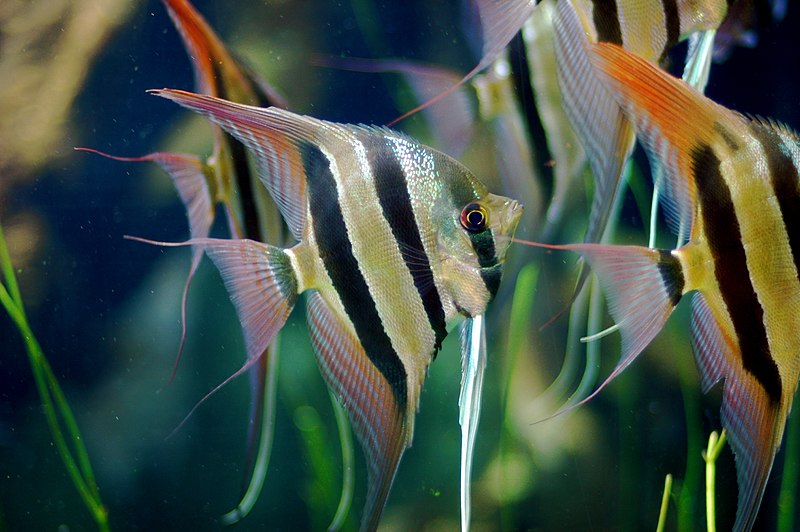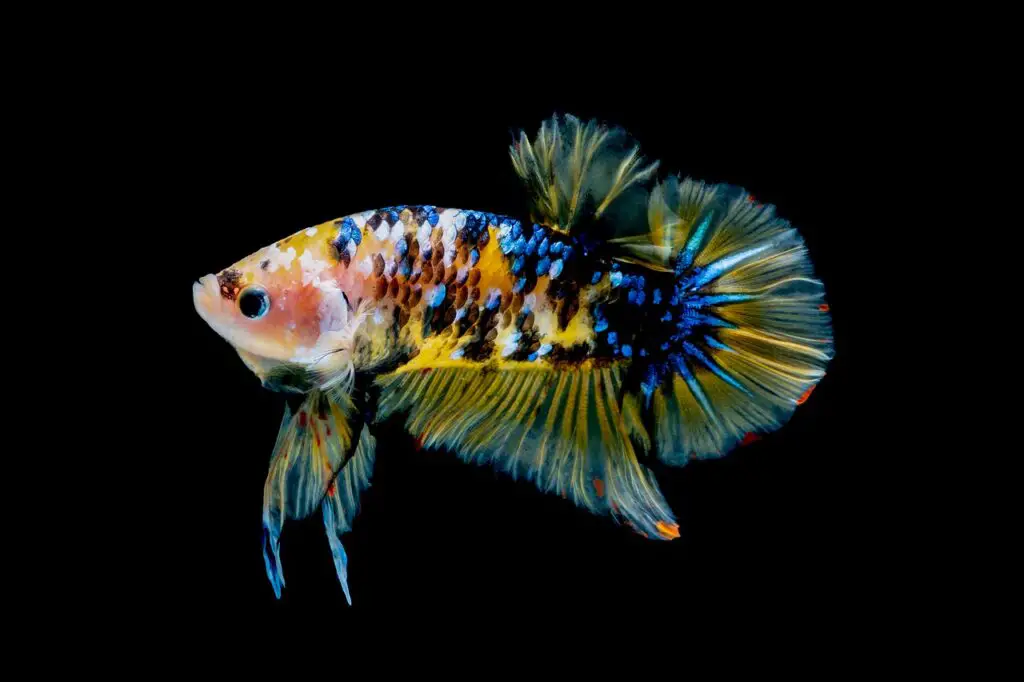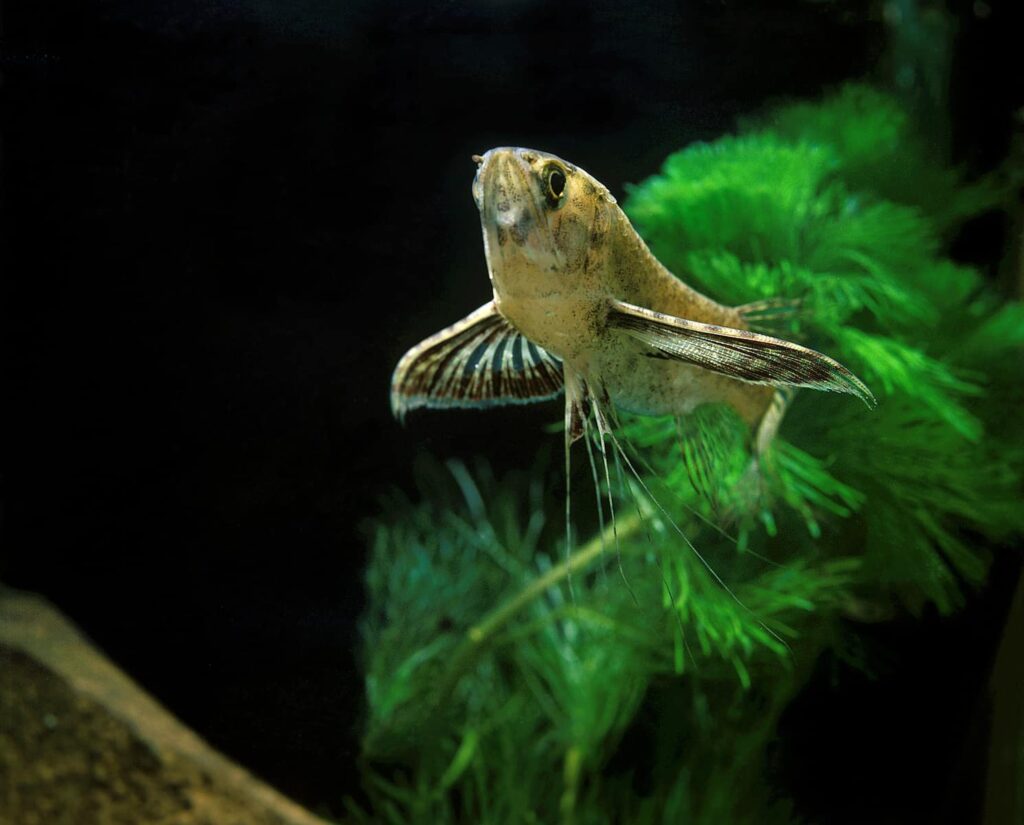Most folks that pursue tropical fish as a hobby have probably kept an angelfish at one time or another. Perhaps there are other fish enthusiasts out there who keep nothing but angelfish. But caring for the Altum Angelfish is a bit more tricky.
If you want to add Altum Angelfish to your tank, read on. This article will go into detail about the Altum Angelfish and the best way to house them, so they are happy and healthy.
What is an Altum Angelfish? What Does She Look Like?
The Altum Angelfish (Pterophyllum Altum) is the largest of the freshwater angelfish. Their pear grey, long dorsal and anal fins reach up to 35-40 cm. Her body is flat on both sides with a disk shape, and her snout is sharp looking.
Her coloring varies from olive with silver, greenish-gray to brownish olive, and she has four lateral stripes. What is interesting about the Altum is that her coloring can change according to her mood.
Altum Angelfish Habitat in the Wild
In the wild, the Altum Angelfish is found primarily in South America, along the Amazon River Basin. They thrive in river watersheds and flood plains that are covered by trees, roots, and vegetation.
The Altum eats not only food particles but small fish and invertebrates as well.
Altum Angelfish Habitat in Captivity
We see angelfish in almost every pet store or fish breeder as they are one of the most popular and easiest fish to care for. But the same does not hold true for the Altum Angelfish. She is very difficult to care for and would do best with an experienced person.
The Altum Angelfish has a high risk of disease and have problems with nitrates. They are very sensitive to water that isn’t conditioned properly and can be troublesome to feed.
What Size Tank Should I Have for Altum Angelfish?
If you want to keep angelfish, you will need a tank that is on the spacious side, something that is at least 150 gallons. The size of the tank would also depend on how many different kinds of fish you have in the tank and your water filtration system.
You should generally follow the rule that one adult Altum Angelfish requires at least 11 gallons of water.
It is best to have your tank located in a quiet but not totally secluded place. Altum Angelfish don’t do well with bright lights or loud sounds and are easily frightened.
What About Substrate?
A tank for an Altum would do best with a thin layer of clean sand at the bottom. Clean sand is a great place for nitrifying bacteria to develop, and they will use food leftovers and prevent pathogenic agents.
Sand substrate is generally easy to clean and put back in the tank. However, there are no specific specifications, and most substrates will be fine.
Should I Have Plants in the Tank?
Having plants in your Altum Angelfish aquarium is important, but there are no limitations on which ones you can use. It will depend on your substrate’s thickness, but Altums are pretty indifferent to plants.
If you decide to use real plants in the enclosure, ceramic containers will work well. Plants with long, wide leaves, such as Echinodorus, may also be good.
Tall plants also help the Altum Angelfish feel safe and lower their stress level.
What about Lighting?
Lighting is important, both for your fish and your plants. A well-lit area, along with shade, is preferred. Light during the day should be about 10-12 hours. Installing a timer to have lighting come on at the same time every day is very helpful.
Lit and shaded areas are important because in the wild, light, and shade fluctuate. The Altum Angelfish needs shade because it helps them to feel safe.
How Does Water Play an Important Factor? How Should I Maintain the Tank?
When keeping Altum Angelfish, it’s essential to have high-quality water in your tank. Because the water in their natural habitat is very soft, you should strive for the same. Even if you have a tank with water that is of middle hardness, you should do okay.
The following three rules should be set for your tank:
- Water Hardness: 0-5 H
- Water pH: 4.8-6.2.
- Water Temperature: 82 to 90 f (28 to 32 C)
It is also important to have a weekly water change schedule. At least 25% of the water should be changed, and any water you put back into the tank needs to be tested.
The Altum is sensitive to water fluctuations, so be sure to vacuum or clean your substrate after each cleaning. But at the same time, you want to do your best not to stress your fish out, as they are prone to this.
What is the Temperament of the Altum Angelfish? Are They Friendly?
In general, the Altum is a friendly fish, but it can become territorial as they age. They are quite peaceful and will pair off with the opposite sex after maturity, where they will form a family.
They are also tolerant of plants in the tank and don’t show aggression towards them.
Diseases of the Altum Angelfish
Like most fish, the Altum Angelfish is not immune to health problems. I’ve listed some of the most common health problems seen in fish below:
- Dropsy: a condition where fluid can build up inside the tissues and body cavity
- Hole in the Head Disease: small holes can actually be seen in the head of the fish and will turn into tubular eruptions
- White Spot Disease: white spots will appear on the skin, fins, and gills of the fish.
- Gill Disease: gills will appear swollen and discolored, with mucous and rapid breathing
- Fish Tuberculosis: The fish will appear hollow-bellied and emaciated and act lethargic
What Should I Feed My Altum Angelfish?
For the most part, Altums are not very picky. They will eat flake foods and living food. They should have high-quality flakes or pellets daily to ensure they get the right nutrients.
They also love brine shrimp and blood worms. Spinach and lettuce can be given as a special treat.
How to care for Altum Angelfish
Most folks that pursue tropical fish as a hobby have probably kept an angelfish at one time or another. Perhaps there are other fish enthusiasts out there who keep nothing but angelfish. But caring for the Altum Angelfish is a bit more tricky.
If you want to add Altum Angelfish to your tank, read on. This article will go into detail about the Altum Angelfish and the best way to house them, so they are happy and healthy.
What is an Altum Angelfish? What Does She Look Like?
The Altum Angelfish (Pterophyllum Altum) is the largest of the freshwater angelfish. Their pear grey, long dorsal and anal fins reach up to 35-40 cm. Her body is flat on both sides with a disk shape, and her snout is sharp looking.
Her coloring varies from olive with silver, greenish-gray to brownish olive, and she has four lateral stripes. What is interesting about the Altum is that her coloring can change according to her mood.
Altum Angelfish Habitat in the Wild
In the wild, the Altum Angelfish is found primarily in South America, along the Amazon River Basin. They thrive in river watersheds and flood plains that are covered by trees, roots, and vegetation.
The Altum eats not only food particles but small fish and invertebrates as well.
Altum Angelfish Habitat in Captivity
We see angelfish in almost every pet store or fish breeder as they are one of the most popular and easiest fish to care for. But the same does not hold true for the Altum Angelfish. She is very difficult to care for and would do best with an experienced person.
The Altum Angelfish has a high risk of disease and have problems with nitrates. They are very sensitive to water that isn’t conditioned properly and can be troublesome to feed.
What Size Tank Should I Have for Altum Angelfish?
If you want to keep angelfish, you will need a tank that is on the spacious side, something that is at least 150 gallons. The size of the tank would also depend on how many different kinds of fish you have in the tank and your water filtration system.
You should generally follow the rule that one adult Altum Angelfish requires at least 11 gallons of water.
It is best to have your tank located in a quiet but not totally secluded place. Altum Angelfish don’t do well with bright lights or loud sounds and are easily frightened.
What About Substrate?
A tank for an Altum would do best with a thin layer of clean sand at the bottom. Clean sand is a great place for nitrifying bacteria to develop, and they will use food leftovers and prevent pathogenic agents.
Sand substrate is generally easy to clean and put back in the tank. However, there are no specific specifications, and most substrates will be fine.
Should I Have Plants in the Tank?
Having plants in your Altum Angelfish aquarium is important, but there are no limitations on which ones you can use. It will depend on your substrate’s thickness, but Altums are pretty indifferent to plants.
If you decide to use real plants in the enclosure, ceramic containers will work well. Plants with long, wide leaves, such as Echinodorus, may also be good.
Tall plants also help the Altum Angelfish feel safe and lower their stress level.
What about Lighting?
Lighting is important, both for your fish and your plants. A well-lit area, along with shade, is preferred. Light during the day should be about 10-12 hours. Installing a timer to have lighting come on at the same time every day is very helpful.
Lit and shaded areas are important because in the wild, light, and shade fluctuate. The Altum Angelfish needs shade because it helps them to feel safe.
How Does Water Play an Important Factor? How Should I Maintain the Tank?
When keeping Altum Angelfish, it’s essential to have high-quality water in your tank. Because the water in their natural habitat is very soft, you should strive for the same. Even if you have a tank with water that is of middle hardness, you should do okay.
The following three rules should be set for your tank:
- Water Hardness: 0-5 H
- Water pH: 4.8-6.2.
- Water Temperature: 82 to 90 f (28 to 32 C)
It is also important to have a weekly water change schedule. At least 25% of the water should be changed, and any water you put back into the tank needs to be tested.
The Altum is sensitive to water fluctuations, so be sure to vacuum or clean your substrate after each cleaning. But at the same time, you want to do your best not to stress your fish out, as they are prone to this.
What is the Temperament of the Altum Angelfish? Are They Friendly?
In general, the Altum is a friendly fish, but it can become territorial as they age. They are quite peaceful and will pair off with the opposite sex after maturity, where they will form a family.
They are also tolerant of plants in the tank and don’t show aggression towards them.
Diseases of the Altum Angelfish
Like most fish, the Altum Angelfish is not immune to health problems. I’ve listed some of the most common health problems seen in fish below:
- Dropsy: a condition where fluid can build up inside the tissues and body cavity
- Hole in the Head Disease: small holes can actually be seen in the head of the fish and will turn into tubular eruptions
- White Spot Disease: white spots will appear on the skin, fins, and gills of the fish.
- Gill Disease: gills will appear swollen and discolored, with mucous and rapid breathing
- Fish Tuberculosis: The fish will appear hollow-bellied and emaciated and act lethargic
What Should I Feed My Altum Angelfish?
For the most part, Altums are not very picky. They will eat flake foods and living food. They should have high-quality flakes or pellets daily to ensure they get the right nutrients.
They also love brine shrimp and blood worms. Spinach and lettuce can be given as a special treat.



